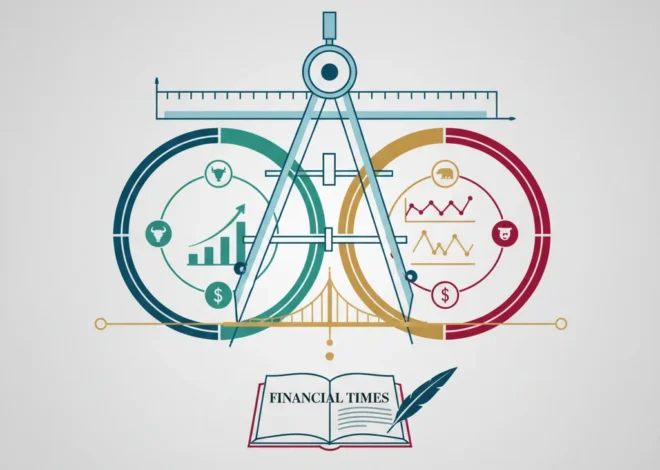
The Miller Doctrine: Decoding the Economic Blueprint for a Potential Second Trump Term
As the 2024 U.S. presidential election approaches, investors and business leaders are moving beyond the daily political horse race to analyze a more critical question: What would a second Trump administration actually do? Unlike the improvisational nature of his first term, a detailed and ideologically driven blueprint is emerging, meticulously crafted by key figures like Stephen Miller. Understanding this plan is no longer just a political exercise; it’s a crucial component of risk assessment for anyone involved in finance, investing, and the broader economy.
Based on insights from a recent Financial Times analysis, a potential second term aims to be a “shock and awe” presidency from day one, armed with pre-vetted personnel, executive orders, and a clear mandate for radical change. At the center of this “government in waiting” is Stephen Miller, whose influence extends far beyond his first-term focus on immigration. He is now a chief architect of a plan to fundamentally reshape the American government and, by extension, its economic landscape.
The Architect: Stephen Miller and the “Government in Waiting”
Stephen Miller, once known primarily as the architect of the Trump administration’s hardline immigration policies, has spent the last four years building an operational framework for a second term. Through his organization, America First Legal, he has been engaged in what the FT’s Edward Luce describes as a “multi-front war” against the current administration, using litigation to challenge policies and simultaneously identify personnel for a future one. This isn’t a shadow campaign; it’s the construction of a parallel power structure ready to assume control.
The key difference this time is preparation. The first Trump term was characterized by a chaotic transition and difficulty in staffing key positions. The second, by design, would be the opposite. The goal is to have thousands of ideologically aligned individuals vetted and ready to fill positions across the federal government on day one. This systematic approach aims to bypass the institutional resistance that blunted many of the first term’s more ambitious goals. For the world of finance and investing, this signals a potential for rapid, disruptive policy shifts with little of the traditional bureaucratic delay.
Pillar 1: Deconstructing the Administrative State
A core tenet of the emerging plan is the dismantling of what proponents call the “administrative state” or “deep state.” This refers to the body of career civil servants and experts who staff federal agencies, from the Environmental Protection Agency to the Securities and Exchange Commission (SEC). The primary tool for this overhaul is an executive order known as “Schedule F.”
Reinstating Schedule F would reclassify an estimated 50,000 federal employees from career professionals with civil service protections to, essentially, political appointees who can be fired at will. The implications for economic and financial governance are profound. Imagine a Federal Reserve, Treasury Department, or SEC staffed not by experienced economists and regulators, but by political loyalists. This could introduce unprecedented political pressure on everything from monetary policy and banking supervision to corporate enforcement.
The resulting regulatory uncertainty would be a significant headwind for the stock market. Industries that rely on stable, predictable regulatory frameworks—such as pharmaceuticals, energy, and especially financial technology (fintech)—would face a new paradigm of risk. The long-term planning essential for capital-intensive projects and technological innovation, including in areas like blockchain, could be stifled by the fear of sudden, politically motivated rule changes.
Solving the Financial Crossword: A Strategic Guide for Modern Investors
Pillar 2: Immigration, Labor Markets, and the Economy
The second pillar of the plan involves an immigration policy that would be, as described in the FT transcript, “shockingly extreme.” The proposals reportedly being prepared are a radical escalation from the first term’s policies and include:
- The largest mass deportation of undocumented immigrants in U.S. history.
- Ending birthright citizenship for the children of undocumented immigrants.
- The potential use of the U.S. military to enforce immigration law internally.
While framed as a matter of national security, the economic consequences would be seismic. The U.S. economy is already facing a tight labor market in key sectors. Removing millions of people, many of whom are employed in agriculture, construction, and hospitality, would create immediate and severe labor shortages. According to the FT discussion, this represents a plan far more radical than anything seen before.
Below is a comparative look at the proposed approach versus the first-term reality, highlighting the shift from targeted actions to a systematic overhaul.
| Policy Area | First Term Approach (2017-2021) | Proposed Second Term Blueprint |
|---|---|---|
| Civil Service | Verbal criticism of the “deep state”; difficulty filling roles. | Systematic replacement of up to 50,000 civil servants via “Schedule F.” |
| Immigration | “Travel ban,” family separations, focus on border wall construction. | Mass deportations, ending birthright citizenship, potential use of military. |
| Trade & Tariffs | Targeted tariffs, particularly on China; ad-hoc trade negotiations. | Proposed universal 10% baseline tariff on all imports, plus further targeted tariffs. |
| Personnel Strategy | Chaotic staffing process with high turnover. | Pre-vetted list of thousands of “loyalist” appointees ready on Day One. |
For those focused on economics, the chain reaction is clear: labor shortages lead to wage inflation, which complicates the Federal Reserve’s efforts to control prices. Supply chains, already fragile, would be further disrupted. GDP growth would almost certainly take a hit. This isn’t just a social policy; it’s an economic one with direct implications for corporate earnings and, consequently, stock market valuations.
Dieselgate's Second Wave: The Billion-Pound Legal Storm Shaking the Automotive Stock Market
Global Economic Tremors: Trade and Foreign Policy
The “America First” doctrine is also set for a more aggressive reboot. Beyond the specific plans for domestic governance, a blanket 10% tariff on all imported goods has been floated. This move would likely trigger retaliatory tariffs from trading partners, reigniting trade wars on a global scale. The disruption to international supply chains would dwarf the turmoil seen during the first term.
Such a policy would have a direct impact on inflation, consumer prices, and corporate profitability. For investors, this elevates the importance of geographic revenue diversification and supply chain resilience in portfolio construction. The stability of the global finance system, which is built on decades of trade liberalization, would be tested. A move toward economic isolationism by the world’s largest economy would create ripple effects impacting every asset class, from equities to currencies. It would force a re-evaluation of the U.S. dollar’s role and potentially accelerate de-dollarization trends, a topic of growing interest in the blockchain and digital currency space.
The BRIC Prophecy: How a 2001 Report Redefined Global Finance and What Comes Next
Conclusion: Pricing in Political Risk
The plans being developed for a potential second Trump administration are not mere campaign rhetoric. They represent a coherent and detailed strategy to fundamentally alter the U.S. government and its relationship with the economy. As Edward Luce noted, the goal is to achieve a level of “autocratic power” unprecedented in modern American history.
For business leaders, investors, and finance professionals, the task now is to move beyond partisan preferences and engage in clear-eyed risk analysis. The potential for extreme regulatory volatility, labor market shocks, and global trade disruptions must be factored into any forward-looking strategy. The coming months require diligent monitoring not of the polls, but of the policies being meticulously prepared behind the scenes. In this new environment, understanding the political blueprint is as fundamental to successful trading and investing as understanding a company’s balance sheet.


